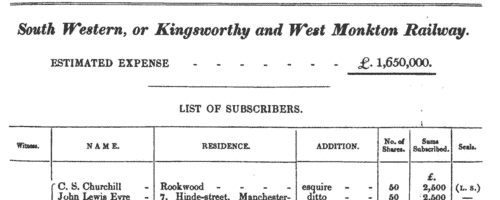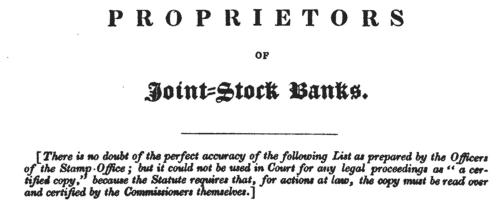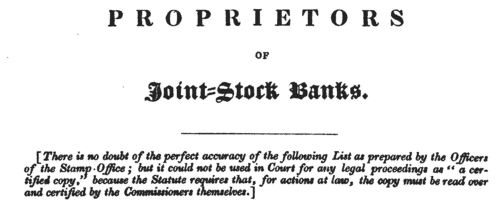Dunkley Surname Ancestry ResultsOur indexes 1000-1999 include entries for the spelling 'dunkley'. In the period you have requested, we have the following 276 records (displaying 101 to 110): Single Surname Subscription | | | Buying all 276 results of this search individually would cost £1,670.00. But you can have free access to all 276 records for a year, to view, to save and print, for £100. Save £1,570.00. More... |
These sample scans are from the original record. You will get scans of the full pages or articles where the surname you searched for has been found. Your web browser may prevent the sample windows from opening; in this case please change your browser settings to allow pop-up windows from this site. South Midlands County Railway Shareholders
(1837)
The return of the railway subscription contracts deposited in the Private Bill Office lists the shareholders in the South Midlands County Railway, subscribers to shares amounting to £605,200 towards the £1,100,000 estimated expense of the project. The list gives full name of each subscriber, address, addition (occupation), number of shares, amount subscribed, and witness's name.DUNKLEY. Cost: £6.00.  | Sample scan, click to enlarge

| South Western Railway Shareholders
(1837)
The return of the railway subscription contracts deposited in the Private Bill Office lists the shareholders in the South Western, or Kingsworthy and West Monkton Railway, subscribers to 24,681 shares amounting to £1,234,050 towards the £1,650,000 estimated expense of the project. The list gives full name of each subscriber (or surname with initials), residence, addition (occupation), number of shares, and sum subscribed.DUNKLEY. Cost: £6.00.  | Sample scan, click to enlarge

| Voters in the Parish of St George, Hanover Square, Westminster
(1837)
A poll was taken 26 July 1837 for the election of two members to represent the City of Westminster in Parliament. The candidates were Lieut.-Col. de Lacey Evans, John Temple Leader, and Gen. the Right Hon. sir George Murray, K. G. C. This poll book lists the electors with full name (surname first) and address (in italics), dashes indicating for whom they cast their votes. The names are listed alphabetically by first letter of surname, arranged in the eight parishes of Westminster, plus the extra-parochial Precincts of the Savoy.DUNKLEY. Cost: £6.00.  | Sample scan, click to enlarge

| Shareholders of the Northamptonshire Banking Company
(1838)
The provincial banks of England and Wales made annual returns to the Stamp Office of their proprietors or shareholders. These returns, registered in March 1838, from the 103 banks then in existence, contain the full names and addresses of nearly 30,000 shareholders.DUNKLEY. Cost: £6.00.  | Sample scan, click to enlarge

| Shareholders of the Northamptonshire Union Bank
(1838)
The provincial banks of England and Wales made annual returns to the Stamp Office of their proprietors or shareholders. These returns, registered in March 1838, from the 103 banks then in existence, contain the full names and addresses of nearly 30,000 shareholders.DUNKLEY. Cost: £6.00.  | Sample scan, click to enlarge

|  London Policemen
(1830-1842) London Policemen
(1830-1842)
The Metropolitan Police Register of Joiners (MEPO 333/4) lists policemen joining the force through to 31 December 1842 (to warrant number 19892). The register is alphabetical, in so far as the recruits are listed chronologically grouped under first letter of surname. It is evidently a continuation of a similar earlier register, not closed until its alphabetical sections were filled: consequently, there are no entries in this register for the initial letters N, O, Q, U, V, X, Y or Z; and the sections of this register start at different dates - A 18 April 1840 (warrant number 16894); B 11 December 1830 (5570); C 7 September 1830 (4988); D 27 May 1833 (8445); E 15 December 1838 (14476); F 30 March 1832 (7372); G 1 December 1835 (11,184); H 25 April 1832 (7457); I and J 13 February 1837 (12449); K 2 January 1838 (13457); L 3 October 1834 (9905); M 15 November 1832 (7999); P 4 October 1831 (6869); R 4 September 1837 (13021); S 30 March 1835 (10366); T 6 April 1840 (16829); W 30 December 1833 (9096). The register gives Date of Appointment, Name, Number of Warrant, Cause of Removal from Force (resigned, dismissed, promoted or died), and Date of Removal. Although the register was closed for new entrants at the end of 1842, the details of removals were always recorded, some being twenty or more years later. Those recruits not formerly in the police, the army, or some government department, were required to provide (normally) at least two letters of recommendation from persons of standing, and details of these are entered on the facing pages: the names in these are indexed separately - this index refers only to the police constables. Where a recruit was only recently arrived in the metropolis, the names and addresses of the recommenders can be invaluable for tracing where he came from.DUNKLEY. Cost: £8.00.  | Sample scan, click to enlarge

|  Persons of standing recommending London police recruits
(1830-1842) Persons of standing recommending London police recruits
(1830-1842)
The Metropolitan Police Register of Joiners (MEPO 333/4) lists policemen joining the force through to 31 December 1842 (to warrant number 19892). The register is alphabetical, in so far as the recruits are listed chronologically grouped under first letter of surname. It is evidently a continuation of a similar earlier register, not closed until its alphabetical sections were filled: consequently, there are no entries in this register for the initial letters N, O, Q, U, V, X, Y or Z; and the sections of this register start at different dates - A 18 April 1840 (warrant number 16894); B 11 December 1830 (5570); C 7 September 1830 (4988); D 27 May 1833 (8445); E 15 December 1838 (14476); F 30 March 1832 (7372); G 1 December 1835 (11,184); H 25 April 1832 (7457); I and J 13 February 1837 (12449); K 2 January 1838 (13457); L 3 October 1834 (9905); M 15 November 1832 (7999); P 4 October 1831 (6869); R 4 September 1837 (13021); S 30 March 1835 (10366); T 6 April 1840 (16829); W 30 December 1833 (9096). The register gives Date of Appointment, Name, Number of Warrant, Cause of Removal from Force (resigned, dismissed, promoted or died), and Date of Removal. Those recruits not formerly in the police, the army, or some government department, were required to provide (normally) at least two letters of recommendation from persons of standing, and details of these are entered on the facing pages: the names in these are indexed here (the police recruits are indexed separately and not included here). Recruits transferred from other forces or rejoining the force did not normally need recommendations - in the latter case, former warrant numbers are given - but some recommendations are from police inspectors, even other constables. Recruits coming from the army sometimes have general military certificates of good conduct, but most often have a letter from their former commanding officer; recruits recommended by government departments (most often the Home Office) similarly have letters from the head of department. But the great majority of the names and addresses in these pages are of respectable citizens having some sort of personal acquaintance with the recruit. Where more than two recommendations were provided, the clerk would only record one or two, with the words 'and others'. Tradesmen are sometimes identified as such by their occupations; there are some gentry. Although the great bulk of these names are from London and the home counties, a scattering are from further afield throughout Britain and Ireland. DUNKLEY. Cost: £8.00.  | Sample scan, click to enlarge

| New South Wales Intestates
(1842)
The probate courts of the Australian colonies furnished returns of estates of deceased intestates, giving full name, colonial residence, supposed British or foreign residence of family (often unknown, or left blank), amount of the estate and how much had been disbursed and how. The date of death is often stated, and if by accident, suicide or crime. Names were carried forward from return to return until the estate was expended or exhausted. DUNKLEY. Cost: £6.00.  | Sample scan, click to enlarge

| Dissolutions of Partnerships
(1844)
Trade partnerships dissolved, or the removal of one partner from a partnership of several traders, in England and Wales
DUNKLEY. Cost: £6.00.  | Sample scan, click to enlarge

| Inhabitants of Derbyshire
(1846)
Samuel Bagshaw's Derbyshire directory lists traders, farmers and private residents in the county by town, parish and/or township.DUNKLEY. Cost: £6.00.  | Sample scan, click to enlarge

|
Research your ancestry, family history, genealogy and one-name study by direct access to original records and archives indexed by surname.
|













